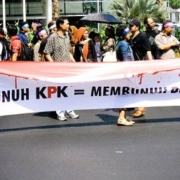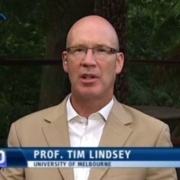
Indonesian courts regularly convict national and local-level elite politicians – something that was almost unheard of during the New Order era. Photo by Sigid Kurniawan for Antara.
When Soeharto’s New Order fell in 1998, Indonesia’s courts were widely considered little more than an extension of executive and military power. But against all odds, the Supreme Court committed to a process of major reform. It is impossible to do justice to the enormous topic of judicial reform since 1998 in this brief article. Nevertheless, I have tried to provide a broad insight into what has been achieved, and what has not, in three key areas: judicial independence; judges’ integrity and accountability; and the judiciary’s role in legal development.
Constitutional and political reform, the ‘One Roof System’ and judicial independence
The amendments to the 1945 Constitution and other reforms have allowed the Supreme Court, and lower courts (high courts at the provincial level and district courts) to enjoy greater autonomy and an improved status. The appointment and tenure arrangements for Supreme Court justices are more independent. Judges also receive much more fitting remuneration and facilities.
The administrative, personnel management and financial affairs of the lower courts, which used to be handled – and abused – by the government, were transferred to the Supreme Court (under the so-called “One Roof System”). Lower court judges are also granted state official status, thus significantly improving their earnings. Other advancements, such as a new administrative model for judicial personnel management separate to that applied to other civil servants, is still a work in process.
These reforms, together with greater separation of power between the arms of government, make courts relatively autonomous from political interference. It is not uncommon for courts to decide cases against the interests of the government, political parties, and big business. This happened, for example, in the Kendeng farmers’ case against Semen Indonesia, the Jakarta Bay reclamation case and numerous others in the environmental sector. Courts now regularly convict national and local-level elite politicians and officials (sometimes with severe sentences). This was almost unheard of during the New Order era. Likewise, the Supreme Court is generally supportive of press freedom. It is also more willing to review the legality of local regulations under national statutes, although there are still major problems with this judicial review process, not least the court’s reluctance to review problematic local regulations concerning religion.
There are, of course, decisions that raise doubt about the extent to which judges are truly free of political intervention, not to mention serious ongoing issues with corruption, where parties can “buy” favourable decisions, even against the interests of the government. Further, “progressive” decisions are not necessarily enforced, by the government and the Court itself. Moreover, the legislature and, to a certain degree, the government continue to influence the judiciary, particularly the Supreme Court, because of their budgeting and lawmaking powers, and in the case of the legislature, its role in supervision and appointment of judges. District court judges face a more serious threat of intervention, because local courts and their leadership are dependent for financial support and facilities on local governments.
The independence of the courts in deciding cases and implementing decisions is also threatened by uncivil elements of Indonesian civil society, particularly in politically and publicly sensitive cases, such as those relating to religion. This intimidation has meant the courts’ autonomy is further compromised when they decide pre-trial hearings challenging police investigations or detention. The courts are aware that they need to keep the police onside to ensure police remain willing to safeguard trials – and the judges – in case that attract public attention.
The “One Roof System”, which aimed to strengthen judicial independence, create better arrangements for the transfer and promotion of judges, and improve budget management, has yet to fulfil its promise. District court judges still complain about a lack of adequate facilities to support their work and the Supreme Court’s management of transfers and promotions. Although improvements have been made, ingrained practices of nepotism and bribery still colour the promotions process.
Corruption and accountability
Widespread judicial corruption is without doubt the most pressing challenge facing the justice sector. This is clearly evident in the large numbers of judges and court staff convicted for bribery following investigations by the Corruption Eradication Commission (KPK) or issued with disciplinary sanctions by the Supreme Court or Judicial Commission. While this also demonstrates improved supervision of the courts, endemic corruption, and the Supreme Court’s unwillingness to cooperate with the Judicial Commission, has seriously undermined public confidence in the judiciary.
In terms of governance, the justice sector has made major strides in transparency and accountability. New financial administration and case tracking systems have reduced some corrupt practices and improved service (although parties still complain they are routinely required to offer an “incentive” to access certain court services). Likewise, thousands of court decisions, at every level, have been uploaded and can be accessed by the public through the Supreme Court’s online decision database (although the data management and search functions need to be improved). The Supreme Court publishes a detailed annual report on court performance, covering issues like the cases decided, new regulations issued, and budget expenditure. These reforms provide greater scope for the public to scrutinise court functions, although they could go much further.
Engagement in legal development and improving access to justice
Over the past 20 years, the judiciary has become much more engaged with legal development in a broad sense, in part because of the government’s failures in this area. This has been driven by the courts’ openness to working with international donors, civil society organisations and pro-reform actors, and champions within the courts, as well as an organisational need for legitimacy. The Supreme Court, for example, “revised” a Criminal Code provision on minor property offences by passing Supreme Court Regulation 2 of 2012 to try to prevent police and prosecutors from detaining offenders in cases of petty theft where the value of stolen goods is less than Rp 2.5 million.
It also passed Regulation 2 of 2015 to set up a small claims court, so that minor tort and breach of contract cases, with a few exceptions, can be processed in a quick and simple manner. The Supreme Court has also passed regulations on corporate criminal liability (Regulation 13 of 2016), on women and children facing legal issues (Regulation 4 of 2014 and Regulation 3 of 2017), among others. The challenge is to ensure that these positive reforms are actually implemented. My research on Regulation 2 of 2012 has found that many judges, including at the Supreme Court, have still not fully applied the regulation, even though it is already six years old.
While this regulation was much needed, the Supreme Court’s growing, and some might say excessive, use of its regulatory function is not without risk. There is little stopping it from issuing policies that are in conflict with the law or the public interest. For example, in 2015, the Court issued a circular instructing judges to reject multiple reconsideration (peninjauan kembali, PK) applications in the same case, violating a Constitutional Court decision on the matter that specifically declared multiple PK applications to be permissible.
At the other end of the spectrum, the Supreme Court has also failed to provide adequate guidance to lower courts to improve legal certainty (notwithstanding the major role played by corruption and poor professionalism in lack of legal certainty). The court has yet to issue a clear directive to lower courts on how they should respond to the heavy handed overcriminalisation of drug-users by police and prosecutors.
By contrast, the religious court system has recorded major achievements in improving geographical, procedural and financial access to courts. Many poor Indonesians, particularly women, have been able access court services to legalise their marriages and divorces, and secure birth certificates for children. These are crucial for accessing government programs, such as free healthcare, subsidised rice, and cash transfers, as well as education subsidies.
Some reflections
Indonesia’s judicial reform process, as Indonesian legal scholar Daniel Lev has noted, has not been a “deep reform”, involving “getting rid of old institutions, replacing them with new ones, and inventing new rules”. The reform process has been gradual, and has involved resistance from power holders and its institutional base. As a consequence, quite remarkable change has been achieved in less “sensitive” areas but reform in other areas is sorely lacking.
The sustainability of political, budgetary and internal court support for judicial reform cannot be predicted, particularly because, aside from access to justice programs, which receive generous government financial support, many reform initiatives have been backed by international donors. The ongoing involvement of civil society organisations in the reform process could be compromised without such support.
Further, meaningful judicial reform relies on change in other institutions – the legislature, in the police, the Attorney General’s Office, and among the legal profession and law faculties – that show even less appetite for reform. On the other hand, energy from several young reform-minded judges offers some hope.
If the reform process is to continue in a meaningful manner, it will require stamina, smart strategies and broader support – both from the public and other state institutions where, sadly, the reform process now seems to have stagnated.







